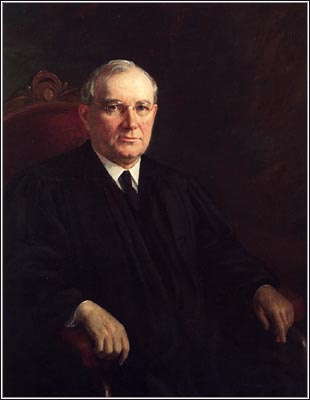- Pierce Butler (justice)
Infobox Judge
name = Pierce Butler

imagesize =
caption =
office = Associate Justice of the United States Supreme Court
termstart =January 2 1923
termend =November 16 1939
nominator =Warren G. Harding
appointer =
predecessor =William R. Day
successor =Frank Murphy
office2 =
termstart2 =
termend2 =
nominator2 =
appointer2 =
predecessor2 =
successor2 =
birthdate = birth date|1866|3|17|mf=y
birthplace = Dakota County,Minnesota
deathdate = death date and age|1939|11|16|1866|3|17|mf=y
deathplace =Washington, D.C.
spouse =Pierce Butler (
March 17 ,1866 –November 16 ,1939 ) was an Americanjurist who served as an Associate Justice of theSupreme Court of the United States from 1923 until his death in 1939. He is notable for being the first justice fromMinnesota , and for being a Democrat appointed by a Republican.Early life
Butler was born to Patrick and Mary Ann Butler, Catholic immigrants from
County Wicklow ,Ireland . (Coincidentally, they only met inGalena, Illinois , even though they left the same part of Ireland for the same reason - the Irish Potato Famine.) Soon, the couple settled inPine Bend (now Rosemount), Dakota County, Minnesota, where Butler was the sixth of nine children born in a log cabin; all but one, his sister, would live to adulthood.He graduated from
Carleton College , where he was a member ofPhi Kappa Psi Fraternity. Admitted to the bar in 1888, he was elected as county attorney in Ramsey County in 1892, and re-elected in 1894. Butler joined the law firm of How & Eller in 1896, which became How & Butler after the death of Homer C. Eller the following year. He accepted an offer to work inSt. Paul, Minnesota , where he took care of railroad-related litigation forJames J. Hill , but returned to private practice in 1905 and rejoined Jared How. He had also served as a lawyer for the company owned by his five brothers. In 1908, Butler was elected President of the Minnesota State Bar Association. From 1912 to 1922, he worked in railroad law inCanada , representing, alternately, shareholders of railroad companies and the Canadian government; he produced favorable results for both. When he was nominated to the United States Supreme Court in 1922, he was in the middle of winning approximately $12,000,000 for the Toronto Street Railway shareholders. He married Annie M. Cronin in 1891.Nomination and Confirmation
Although he was supported by Chief Justice and former President
William Howard Taft , Butler's opposition to "radical" and "disloyal" professors at theUniversity of Minnesota (where he had served on the Board of Regents) made him a controversial Supreme Court nominee when proposed by Republican PresidentWarren Harding . Senator-electHenrik Shipstead of his home state opposed him, as did Progressive SenatorRobert M. LaFollette, Sr. ofWisconsin . Also against his confirmation were labor activists, some liberal newspapers (the New Republic andThe Nation ), and theKu Klux Klan . However, with the support of prominent Roman Catholics, fellow lawyers (the Minnesota State Bar Association strongly endorsed him), and business groups (especially railroad companies), as well as Minnesota's other senator,Knute Nelson , he was confirmed by a wide margin of 61 to 8. The Senators who voted against him were five Democrats (Walter F. George ,William J. Harris ,J. Thomas Heflin ,Morris Sheppard , andPark Trammell ) and three Republicans (Robert M. LaFollette, Sr.Peter Norbeck , andGeorge W. Norris ). He took his seat on the Court onJanuary 2 ,1923 .Time on the Court
While on the Court, Butler vigorously opposed regulation of business and the handing out of welfare by the government. He voted against many of fellow Democrat Franklin Roosevelt's "
New Deal " laws that came before the Court, earning him a place among the so-called "Four Horsemen," which also includedJames Clark McReynolds ,George Sutherland , andWillis Van Devanter . He wrote the majority (6-3) opinion inUnited States v. Schwimmer , where the Hungarian immigrant's application for citizenship was denied. InPalko v. Connecticut , he was the lone dissenter on the court; the rest of the justices believed that a state was not restrained from trying a man a second time for the same crime. Butler believed this violated theFourteenth Amendment to the United States Constitution . InBuck v. Bell , Butler was the only Justice who dissented from JusticeOliver Wendell Holmes, Jr. 's opinion holding that the forced sterilization of an allegedly "feeble-minded" woman inVirginia was constitutional. Although Butler dissented in both "Buck" and "Palko", he did not write a dissenting opinion in either case; the practice of a Justice's noting a dissent without opinion was much more common then than it would be in the late twentieth and early twenty-first centuries.He died in
Washington, DC , at the age of 73 while still on the court. He is buried in the Calvary Cemetery in St. Paul.References
* [http://air.fjc.gov/servlet/uGetInfo?jid=335 Pierce Butler’s Judicial profile]
* "A Supreme Court Justice is Appointed", David J. Danelski.Random House . Copyright 1964.
Wikimedia Foundation. 2010.
